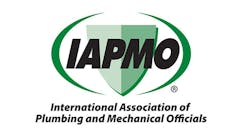Latest from Codes
Sponsored
Eric Truskoski is Vice President of Administration & Government Affairs for Bradford White Corp. While his current focus is government regulation—both studying its impact, anticipating its demands, and lobbying for changes—he comes to the position from the engineering side of the business, having worked in product development as a design engineer, laboratory manager and engineering manager.
CONTRACTOR had the opportunity to speak with Truskoski about the rapidly evolving regulatory environment, the role of the manufacturer, and opportunities the future might present for specifiers, installers and maintenance professionals.
CONTRACTOR: To what do you attribute the change in the regulatory environment in recent years? Is it more than just a new administration in the White House? Do concerns regarding climate change play a role? Does political polarization play a role?
Eric Truskoski: There are many factors that are contributing to the current regulatory environment from the fundamental change in priorities between the previous and current administrations to the global socio-economic challenges we are facing, such as climate change, supply chain issues, lingering pandemic concerns, war, and so on.
Certainly, since the changeover to the Biden administration, we have seen a significant increase in regulations that affect our industry and ultimately our customers and society at large. Some of the pending regulations are based on the regular DOE regulatory review cycle but other actions at the federal and state levels have been accelerated by climate change concerns.
The topic of climate change (aka “global warming”) does play a role and has been the catalyst for a lot of the emotionally charged commentary that has overtaken this critically important issue where we need to have productive conversations on how to deal with this challenge. To work to combat climate change, several factors have to be considered, such as, but not limited to: effective infrastructure development and energy management; energy security; and supply chain concerns. The latter is important, as it has great implications when it comes to where the value content will be coming from and the impact it will have on US jobs.
The complexity of the climate change issue and the extreme views regarding how to address the matter have created the significant polarization that we see today across political parties and public interest groups.
CONTRACTOR: What are the challenges for a manufacturer (like Bradford White) trying to negotiate this new environment? Can technology deliver both the efficiencies regulations demand and the performance end users demand, or is there always going to be a trade-off?
Truskoski: There are certainly challenges presented when engineering and manufacturing products to meet current and pending regulation, especially given that the pace and frequency of these regulations is unprecedented. Not only do manufacturers have to design to the required standards, but they must also do so without disregarding the everyday issues that our plumbing and HVAC customers deal with, such as safety, structural constraints, fuel availability, installation capabilities, costs, and of course the varied needs of their residential and business customers.
Manufacturers must gear up to manufacture for the future while still producing product that is needed to support the current landscape, which is not an easy transition. So, leading into your second question of being able to meet both regulatory and customer demands, unfortunately this is not a simple yes or no answer.
Fundamentally, we can make products to meet regs and customer performance demands. But performance for professional contractors also includes factors, such as cost and ease of service and installation. When you look at what is coming in terms of the next generation of residential and commercial products, there are many in our industry concerned about new space and venting constraints along with fuel limitations that will greatly affect costs (both first and operating) and consumer choice when it comes to their water and space heating options.
CONTRACTOR: How will the new regulatory environment affect equipment specifiers and installers performing new construction and replacement work? Will it require more training? Will there be new costs to be passed on to customers? Will governments or utilities take on some of these costs in the form of rebates?
Truskoski: As I mentioned, all segments of the plumbing community and their residential and commercial customers will be affected to varying degrees by the products and energy options that will emerge because of the current regulatory environment.
Training will certainly be paramount for the plumbing and HVAC community to come up to speed on the newest products as well as the newest regulations and codes that will affect how and where they can install these products.
As the regulatory requirements drive product complexity, the product and installation costs will go up commensurately, and with there being a push towards heat pump technology. It will likely mean multiple trades will need to be involved with installations (i.e. - plumbing and electrical contractors). A portion of the cost burden for consumers can be offset by various tax incentives and rebates, some of which emerged at the beginning of this year as a result of the Inflation Reduction Act (IRA).
At the state and local levels, there are programs that are currently offering rebates, but as higher efficiency products become the minimum requirement, we anticipate rebates will go away and consumers will need to bear the entire costs.
Looking at the installation and cost challenges from a commercial perspective, building and facility managers regulated into heat pump only options are looking at commercial products as much as 20 to 30 times the size of the equipment they are using now and at much higher procurement and installation costs.
CONTRACTOR: What opportunities are there for specifiers/installers in this “new normal”?
Truskoski: Understanding and being on the forefront of the new product and regulatory environment will allow them to learn as demand is low, incentives are available, and there are still a broad set of options to use. That is a key opportunity. For those who have a head start on these changes and the new equipment, it will be a much easier transition as certain technologies like heat pump water heaters become more of the norm in residential and business applications.
If you are taking the position of dealing with it all when it gets here, you may be putting your business at risk. It is not a matter of if these products will be required, but rather, when they will be required. Additionally, we recommend that all specifiers and installers, not just Bradford White customers, use their voice. If you see something coming down the pike that you believe is not in the best interest of your ability to effectively serve your customers and their needs, then it is imperative for you to voice those concerns to national, state, and local lawmakers, either on your own as a concerned citizen or through the professional and industry organizations to which you belong.


